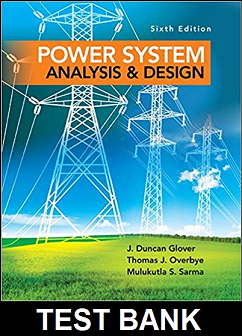Test Bank For Power System Analysis And Design SI Edition 6th Edition By Glover
Digital item No Waiting Time Instant DownloadISBN-13: 978-1305636187 ISBN-10: 130563618X
In Stock
Original price was: $65.00.$28.00Current price is: $28.00.
Test Bank For Power System Analysis And Design SI Edition 6th Edition By Glover
- ________ / 25
- ________ / 20
- ________ / 25
- ________ / 30________ / 100
3. (25 points total)A 3-phase, 60Hz, 50km long, completely transposed transmission line is built using Drake conductor. Drake conductor has an outside diameter of 1.108 inches; stranding of 26/7 (Al/St), which yields a GMR for the conductor of 0.0375 feet. Resistance at 60-Hz for this conductor is 0.117 /mile. A horizontal tower configuration is used, with a phase spacing of 25 feet (25 feet between left and center phases, 25 feet between center and right, and hence 50 feet between left and right). Bundling is used, with 2 conductors per phase, spaced 1 foot apart. For reference μ0 = 4π x 10-7 H/m and Ɛ0 = 8.854 x 10-12 F/m.
- a) Find the positive sequence inductance in H/m and inductive reactance in Ω/km.
- b) Find the capacitance to neutral in F/m and the admittance to neutral in S/km. Neglect the effect of the earth plane.
- c) Since the line is 50km, we can make the short line approximation. Draw the short line π equivalent circuit, labeling appropriate values.
For reference = 4 x 10-7 H/m and 0 = 8.854 x 10-12 F/m. There are 1609 meters per mile.
Multiple Choice. Circle the most correct answer. Ten problems, three points each for a total of 30 points.Note this Problem Continues on the Next PageAs discussed in class, the most common load model for the power flow is
- Constant impedance
- Constant current
- Constant power
We can
- All loads and sources are Y connected
- All loads and sources are delta connected
- There is no mutual inductance between phases
- A and C
- B and C
Which statement about phase and line voltages (V) and currents (I) in Wye and Delta connections is correct?
- Phase I = line I in Wye, and phase V = line V in Delta
- Phase I = line I in Delta, and phase V = line V in Wye
- Phase I = line I and phase V = line V in Wye
- Phase I = line I and phase V = line V in Delta
Using Newton’s method to solve the equation x2 –sin(x) – 2 = 0, with an initial guess of x=1 (that is, its value at the zero iteration), select the value that is closest to the value of x after the second iteration:A. 1.6754 B. 1.7775 C. 1.8073 D. 2.3041 E. 2.3253The impedance of a 10 MVA, 22/220 kV transformer is 0.2 per unit. What is this impedance in per unit for a power base of 10 MVA, and a voltage base of 11 kV on the low voltage side of the transformer?
- 0.05 p.u.
- 0.1 p.u.
- 0.2 p.u.
- 0.4 p.u.
- 0.8 p.u.
- Transformer open circuit (OC) and short circuit (SC) tests allow us to calculate certain equivalent circuit values. Which parameters are calculated from the OC test and which are from the SC test?
- The OC test gives the resistances and the SC test gives the reactances
- The OC test gives the series impedance and the SC test gives the shuntadmittance
- The OC test gives the shunt admittance and the SC test gives the seriesimpedance
- The OC test gives the voltages and the SC test gives currents


Reviews
There are no reviews yet.